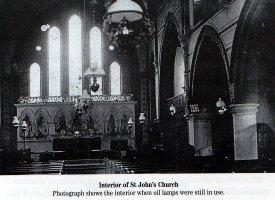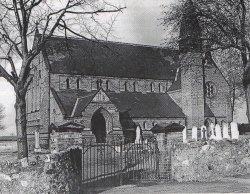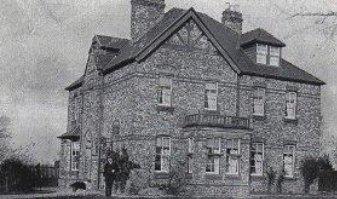St. John the Divine - The History
In 1872, the Rev. William Cassidi being vicar of Grindon at that time, formed the Parish which by decree 'shall be named The District of Stillington' - the village of Stillington was then known as the Village of Carlton Iron Works. The Parish was formed from parts of the Parishes of Grindon (above Railway line) and Redmarshall (below Railway Line). In 1980 the parishes of Stillington & Grindon were combined and in 1982 combined with Redmarshall, Bishopton and Great Stainton (which had already combined in 1977)
Life for the church started with services in a carpenters shop on the Industrial site, then in Cassidi Hall (built in 1875, bottom of West St)
The Vicarage was built in 1884 for £1,850 and in 1982 when the parishes combined the building was sold to become a private dwelling, until then the resident vicar lived in Morrison Street, which was adjacent to the land secured from Carlton Iron Works for the site of the church. The Churchyard was consecrated in 1877.
1879 The school closed on Jan 23rd. 1879 to allow the holding of a luncheon where dignitaries of the church and invited guests coul celebrate the laying of the church foundation stone
The church dedicated to St John was erected on the hillside to the east of the Railway Arch and beyond the top of Morrison Street and Lowson Street. The church was of brick construction with a Gothic style stone finish and a grey slate roof. The interior consisted of a nave, a small side chapel, a vestry and an entrance porch at the west end of the south wall.
The Nave was separated from the chapel by an arcade of bays supported on stone pillars with beautiful carved caps, from which sprang the graceful moulded arches. The combination of stone and brick was employed to good effect and the interior of the church was well balanced and had both aesthetic and reverential appeal.The Pulpit and seats were made from pitch pine and provided seating for over 200 people.
The church had a square tower that housed a single bell and supported a pyramid shaped, grey slated steeple with a distinctive weather cock mounted at its apex. The Architects of the church were Alexander and Henman. The total cost of building was £2,822.
Artificial light was originally provided by oil lamps but was replaced by electric lights around 1930 the cost of which was financed by the Kirk family, who also donated fund to convert the lights in the chapel.
The consecration of the church was carried out by the Bishop of Durham the Most reverend Lightfoot on the morning of Tuesday 29th June 1880, followed by a luncheon in the school.
The first baptism in the church was on July 11th 1880 and the first wedding July 19th 1880 between John Airey of Halifax and Elizabeth Daniels from the village
At the end of the 1914-1918 1st. World War, the Golden Eagle Lectern was purchased by local parishioners as a memorial dedicated to the local men who had served, 30 of whom lost their lives and are are remembered on the Roll of Honour plaque in the Church, another plaque hangs on the North Wall erected in 1925 recording the dates of Office of all the vicars from 1872. During the 2nd. World War due to lack of repair the building fabric deteriorated with broken windows etc. In 1948 Rev Jasper replaced the East Window with Special Plain Glass and the West window as a Memorial Window to those who had served in the 1939-1945 World War Two, he also motivated the redecoration of the interior.
In 1978, dry rot in the roof structure was found, quotes were reported at £30,000 and by 1980 the building was reported unsafe, however local parishioner Peter Featherstone devised a method of replacing the 5 plynth, sprocket and trusses which supported main roof timbers and with the help of Peter Dilks completed the job at a cost of £300. - fish plates had been donated by Clarks and scaffolding loaned by Mr Hesletine of Thorpe, earning them all congratulations from the diocean Architect and the eternal gratitude of the congregation.
Rev Jasper also started 'The Stillington Parish Players' who performed several Gilbert & Sullivan comic operas.
Rev. Weare in his time formed the Companies of both Boys and Girls Brigades also Brownies.
1983/84 Cleveland County Education Authority planned to close Wynyard and Stillington Schools, after protest, it was decided to combine the two and make Stillington a Church of England School. It was agreed to rename the school William Cassidi after the vicar who started the Parish and secured the church in the village
..........................................................................................................................................................................................................................................



interior exterior Vicarage
- Vicars
- 1. John Allen Parker 1872 - 1875
- 2. Thomas Varley 1875 - 1891
- 3. Firth Newsome 1891 - 1918
- 4. Reginald Victor Bury 1918 - 1924
- 5. Evan Morris Young 1924 - 1927
- 6. John Casson Douglas 1927 - 1939
- 7. Charles John Lockyer 1939 - 1948
- 8. Ronald Claud Dudley Jasper 1948 - 1955
- 9. Alex Moore Smith 1955 - 1963
- 10. John Derek Hodgson 1963 - 1966
- 11. John M. Davy 1966 - 1969
- 12. Oswald W. Weare 1969 - 1977
- 13. Leonard Constatine 1977 - 1982
- 14. Timothy J D Ollier 1983 - 1988
- 15. Malcolm Goodall 1990 - 1998
- 16. Ian Jelly 2001 - 2003
- 17 David M Brooke 2004..........